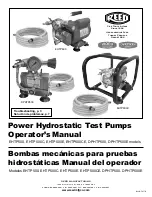
- 4 -
eFlowNB - Power Supply/Chargers
Installation Instructions:
Wiring methods shall be in accordance with the National Electrical Code/NFPA 70/NFPA 72/ANSI, the Canadian
Electrical Code and with all local codes and authorities having jurisdiction. Product is intended for indoor use only.
1. Refer to Sub-Assembly Installation Instructions for mounting Rev. MS050913.
2. Set desired DC output voltage by setting SW1 to the appropriate position on the power supply board
(Fig. 1i, pg. 4).
3. Connect unswitched AC power (120VAC 60Hz) to terminals marked [L, G, N] (Fig. 1a, pg. 4).
Use 14 AWG or larger for all power connections. Secure green wire lead to earth ground.
Keep power-limited wiring separate from non power-limited wiring (120VAC 60Hz Input, DC Output
(refer to Specifications chart pg. 2)
, Battery Wires). Minimum 0.25” spacing must be provided.
CAUTION: Do not touch exposed metal parts.
Shut branch circuit power before installing or servicing equipment.
There are no user serviceable parts inside. Refer installation and servicing to qualified service personnel.
4. Measure output voltage before connecting devices. This helps avoiding potential damage.
5. Connect devices to be powered to terminals marked [– DC +] (Fig. 1h, pg. 4).
For auxiliary device connection this output will not be affected by Low Power Disconnect or Fire Alarm
Interface. Connect device to terminals marked [+ AUX –] (Fig. 1f, pg. 4).
6. For Access Control applications batteries are optional. When batteries are not used, a loss of AC will result
in the loss of output voltage. When the use of stand-by batteries is desired, they must be lead acid or gel type.
Connect battery to terminals marked [– BAT +] (Fig. 1g, pg. 4). Use two (2) 12VDC batteries connected in
series for 24VDC operation (battery leads included). Use batteries - Casil CL1270 (12V/7AH), CL12120
(12V/12AH), CL12400 (12V/40AH), CL12650 (12V/65AH) batteries or UL recognized BAZR2 batteries of
an appropriate rating.
Note: Separate enclosure must be used for housing 40AH or 65AH batteries.
7. Connect appropriate signaling notification devices to AC FAIL & BAT FAIL (Fig. 1b, pg. 4) supervisory
relay outputs.
8. To delay AC reporting for 2 hrs., set SW2 to appropriate dip switch position [AC Delay] (Fig. 1c, pg. 4).
9. To enable or disable Low Output Power Shutdown set SW2 to appropriate dip switch position [Shutdown]
(Fig. 1c, pg. 4).
10. A short or NO or NC input triggers FACP [Trigger EOL Shutdown] (Fig. 1d, pg. 4).
11. Place a jumper for non-latching FACP. A momentary short on these terminals resets FACP latching
[Trigger EOL Shutdown] (Fig. 1e, pg. 4).
Fig. 1 - eFlowNB configuration
L
G
N
NC C NO NC C NO
BAT FAIL
AC FAIL
---
DC
+
AC
AC1
DC
---
BAT
+
+ AUX –
TRIGGER EOL
SUPERVISED
Input
Fuse
Battery Fuse
NO GND
RESET
OFF
---
24
V
ON
---
12
V
enable
disable
1 min.
2 hr.
AC DELAY SHUTDOWN
O
N
1a
1b
1g
1h
1e
1f
1d
1c
1i
ON


























